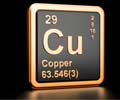A new study has revealed how Pseudomonas aeruginosa uses copper to make an antibiotic called fluopsin C.

‘Copper in small quantities is an essential nutrient but can also be toxic. Human immune cells use copper to fight invading pathogens. Some microorganisms, in turn, have evolved ways to take up copper and incorporate it into biological molecules, either as a way to absorb copper for nutrition or to neutralize its toxic effects.’





Fluopsin C was discovered in 1970. It is a broad-spectrum antibiotic that kills a wide range of bacteria and fungi, including strains resistant to other drugs. Electron paramagnetic resonance
Li’s team at UNC followed the uptake of copper by cultured P. aeruginosa and showed that the copper atoms were incorporated into fluopsin C.
They worked with Lizhi Tao, postdoctoral fellow in Professor David Britt’s lab at the UC Davis Department of Chemistry, using electron paramagnetic resonance, or EPR, to study the synthetic pathway. The researchers found that two small sulfur-containing molecules bind to each copper atom in a mix of cis and trans isomers.
The study shows how Fluopsin C could be synthesized by an enzymatic process instead of using hazardous chemicals. Repurposing copper into an antibiotic in this way is a different response from processes in most organisms, which either sequester or export the metal from the cell, Li said.
Advertisement
Additional authors on the paper are Jon Patteson, Andrew Putz, William Simke and Henry Bryant III, all at UNC. The work was supported by grants from the NIH and a Packard Fellowship to Li.
Advertisement















